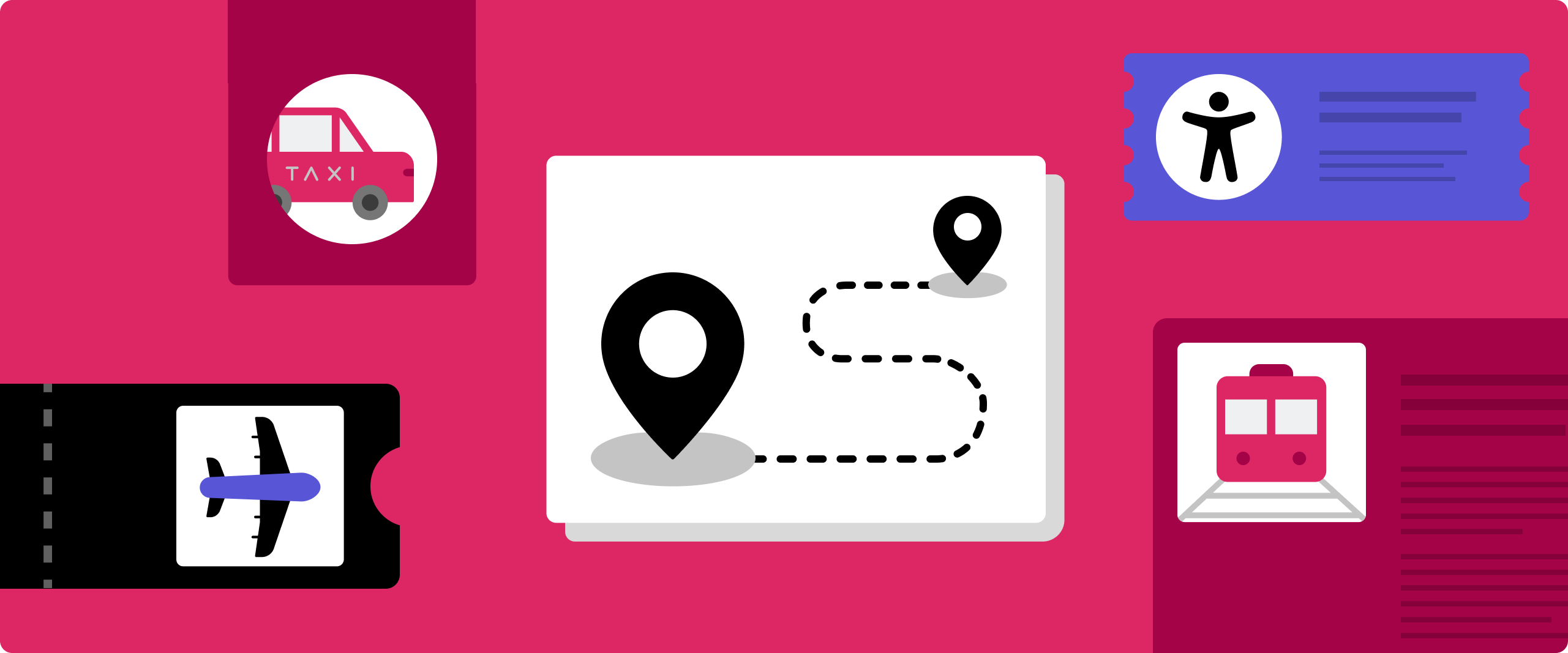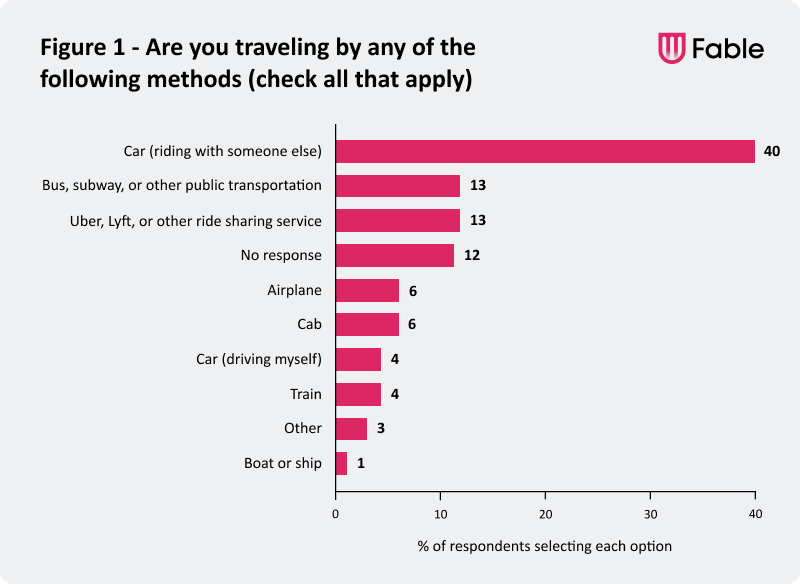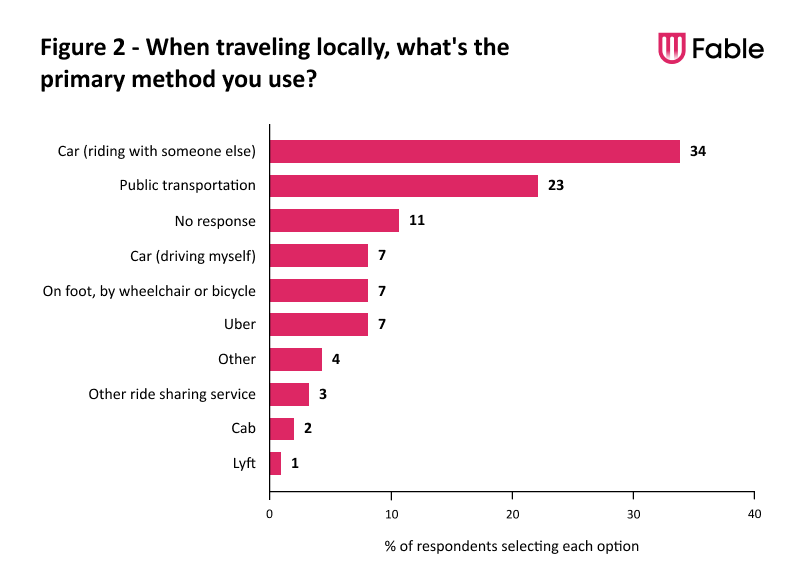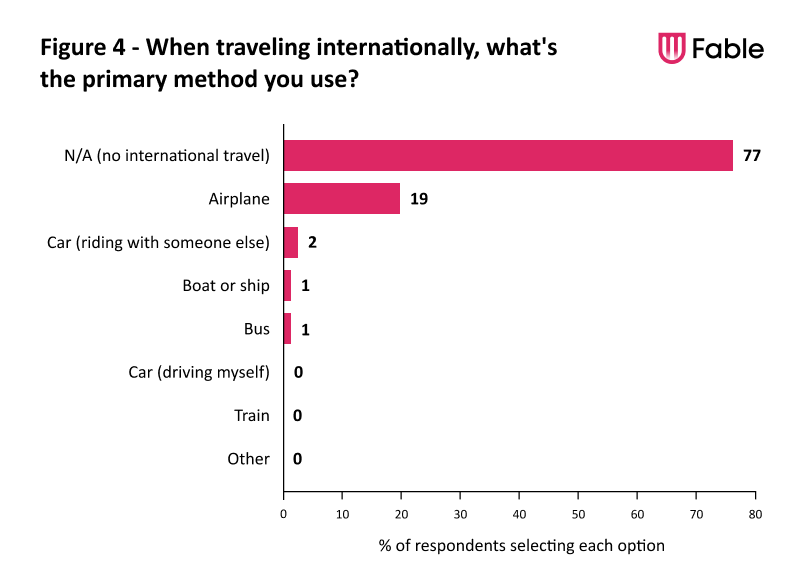
Insights: Accessibility challenges in travel
For people with disabilities it’s the destination, not the journey
The holiday season is the busiest travel time of the year; according to Deloitte, 48 percent of North Americans intend to travel this year, with AAA estimating over 115.2 million travelers intend to go at least 15 miles. For many, that means busy airports, travel delays, overbooked accommodations, traffic, and whatever mother nature might have in store.
Fable recently conducted a survey of our community, all of whom use assistive technology, to learn more about their upcoming and past experiences with travel. The proportion of Fable’s community who are planning to travel this year is approximately equal to those of the general population, with 45 percent intending to travel outside of their home city, and 81 percent planning to travel at least short distances. For these travelers, the potential challenges and frustrations go beyond crowds, delays and weather.

Our survey revealed several common themes experienced by people with disabilities as they travel, regardless of the method they choose. Of those who planned to travel for the holidays, 40 percent intended to travel as a passenger in someone else’s car. Traveling by bus or train landed in second at 17 percent, with flying a distant third.
There’s a well-known aphorism that it’s not the destination, but the journey that matters. For our community of assistive technology users, this isn’t the case; most people are traveling to connect with family or friends, rather than for leisure or pure enjoyment.
“If it wasn’t for seeing family I might not travel at this busy time.” – Jamie H.
In this article, we’ll share some of the common barriers reported for three types of travel: local, national, and international.
Local travel: public transportation, ride sharing, and cabs
When traveling locally, only 7 percent of people with disabilities in Fable’s community would drive a car themselves, with 70 percent relying on others for rides through public transportation, cabs and ride sharing apps. That said, only a quarter of our community uses public transportation as their primary method.

Many factors contribute to public transit not being a preferred method for 77 percent of respondents, including a lack of options where they live, poor accessibility and the unreliability of paratransit. When it comes to cabs or ride sharing, 10 percent have experienced being refused rides because of their service animal. Even when a ride isn’t refused directly, locating this form of transportation can present its own unique challenges.
“I am often confronted by cab drivers and told that they will not take me and my guide dog. She is a large dog, but that does not, nor should it matter. It is the law, and I no longer just let it happen.” – Kostantino B.
With ride sharing or cab hailing apps, the accessibility of the app itself is only a portion of the full travel experience. Booking travel when you’re warm and comfortable at home is an entirely different experience than trying to connect with a driver when you’re out in the cold, in a potentially unfamiliar place.
“I was at a bank, and I didn’t know that the bank I was at and the bank I put into the app were the same bank, just off by one street. I told the driver where I was and he told me that he didn’t see me, and before I could tell him where I was, he canceled the trip and put me down as not wearing a mask.” – Kenny C.
Until the day when every person with a disability can own a self-driving car of their own, there are many things the industry can do to help make travel easier for everyone. First, educating drivers about the needs of people with disabilities is critical. Penalizing drivers for refusing rides does not encourage the right behaviour. Our survey revealed strong sentiments around the need to help drivers understand the needs of their passengers, in order to ensure that everyone can get a worry-free ride when they need it. Second, governments need to focus on making sure that access to public transit is easy and reliable for everyone.
“Since we use Uber, Lyft and other ride services, educating their drivers would really be helpful.” – Jan A.
National travel: trains, buses, and long drives
When traveling nationally, airplane is the preferred method for Fable’s community, with efficiency and speed being the most common contributing factors. This makes travel that’s too far for public transit, or cabs, quickly become an expensive proposition for people with disabilities.

While flying may be the most efficient option for many, people with disabilities still find flying a stressful, and unpleasant experience. The difficulties that come with airport travel will be discussed in more detail in the section on international travel; however, it’s important to mention as it poses a major barrier for national travel, too.
“I have no other option. I would vow to never fly airlines if I could.” – Ross M.
National travel also requires more planning for people with disabilities than it does for other travelers. Factors like health insurance, protecting assistive devices, and minimizing costs fall on travelers who are disabled even when traveling within the same country. Will the destination be accessible? Will they be able to get the accommodations needed during the travel process? How will they travel around once they are at their destination? All of these questions require careful thought and energy, even when traveling from one state to another.
“The hotel didn’t have a vehicle with a ramp, so I couldn’t travel too far from the hotel I stayed.” – Kristopher S.
In order to improve the national travel process for people with disabilities, the first step must be ensuring that accessibility information is easily available during the planning stage. When booking travel or accommodations, 49 percent of respondents with disabilities report doing so online. However, Fable’s community research panel report revealed that travel websites were found to have the most accessibility challenges of any industry. If airlines, hotels, and others in the travel industry ensure that they have websites that are accessible and easy to use, this will help make national travel easier for everyone. Secondly, people with disabilities don’t want to fly nationally if they can avoid it, but access to alternative options are limited. Many members of Fable’s community shared experiences of being unable to access trains or buses at all, due to lack of accessibility. This could mean the services themselves were inaccessible, or stations were located in an area they couldn’t easily get to.
International travel: airplanes, airports, and the barriers in the sky
It’s worth noting that 77 percent of respondents never travel internationally or do so less than once a year, which says a lot about the state of international travel for people with disabilities. Of those who do travel internationally, 88 percent choose to fly but the vast majority do not enjoy the experience. People with disabilities often feel powerless at airports and are subject to uncomfortable situations that many other travelers would never encounter.

“I was traveling from North Carolina to Detroit. I had a three month old baby with me. … They informed me that they would need to take my son away from me and carry him for me. It was an absolutely horrific time for me as a new mom. How could they expect a mom of an infant to hand over their baby to perfect strangers? I could not believe my ears. It infuriated me then and when I recall the memory, that fury still bubbles up. I’m sure that they would not even dream of making such a suggestion to passengers without disabilities.” – Carrie M.
Our survey uncovered countless experiences where accessibility or mobility devices have been taken away, inadequate assistance provided, or unhelpful forms of accommodation offered. All too often, mobility or accessibility devices are returned damaged or they’re never returned at all. We’ve seen a rise in media attention about these instances, but rebuilding trust and a viable solution still feels far away to many. When travelling by air, people with disabilities continue to face additional travel delays, encounter staff members who lack the knowledge to support them, and find themselves unable to advocate for their needs.
“When I went to France, with my electric wheelchair, there were issues with both flights. On arrival, they gave me my wheelchair with the batteries removed. It required tools to put everything back together, so we had to find a maintenance person with tools and figure out what to do. Then, when leaving from Paris, I watched from the window, unable to do anything, and a man dragged my chair up the steps and into the plane.” — Yvette H.
The trust that people with disabilities have in the airline industry has been eroded to an all-time low. As far as they’re concerned, regulations about how assistive devices should be handled are no longer enough. The most frequently requested solution to these problems is that people who use wheelchairs be allowed to keep them with them on the plane, either close to them, or even better, to be able to drive them directly onto the plane themselves. Secondly, people with disabilities want to see better training for airport staff on how to meet their needs; there is a universal frustration by the constant mistreatment of assistive devices and their experiences as passengers.
“If I could get on a plane without having to get out of my wheelchair, this would overall improve the experience drastically.” — Michael D.
Conclusion
These insights make it clear why over 80 percent of Fable’s community experiences some form of travel anxiety. When people find an experience difficult, stressful, and unpleasant, they’re going to avoid it whenever possible. People with disabilities would love to travel for fun, go on vacations, and explore the world like anyone else, but the travel industry needs a transformation. A transformation from an experience of discomfort and uncertainty, into one of joy, discovery, and adventure. Companies that are actively prioritizing accessibility are helping to provide memorable experiences that people with disabilities will treasure and share for years to come. For those who aren’t yet, a massive opportunity lies ahead to better serve an untapped market of travellers, and unlock growth across the globe.
“This summer I took a 40-hour train journey across North America… I discovered the joys and strengths of train travel. The respectful and efficient boarding process, combined with the attentive staff who understood and catered to my needs, made for a seamless and dignified travel experience. This trip not only met but exceeded my expectations, illustrating the profound potential of train travel to offer accessibility and comfort.” — Chase B.
